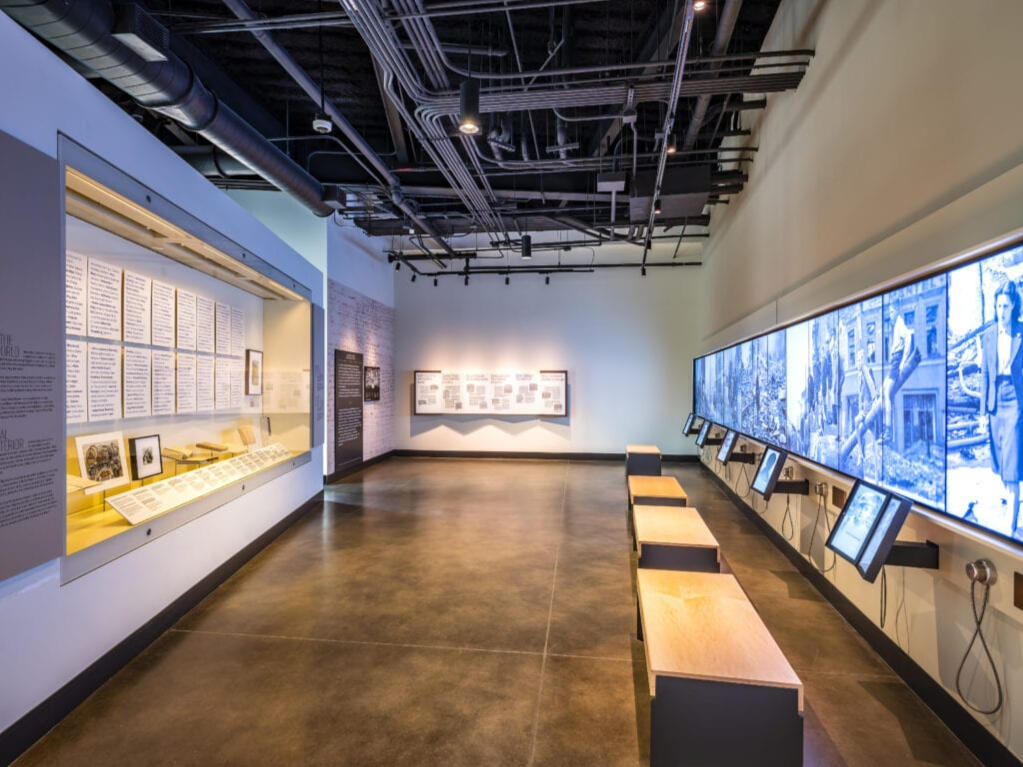And Still I Write introduces museum visitors to young writers who made a mark on history by keeping diaries during times of upheaval. We will use best practices in museum, Holocaust and human rights education to help middle and high-school students, educators, and families explore the exhibition’s themes and inspire them to engagement and action.

The purpose of the Diaries Institute is to engage students of all backgrounds by sharing young people’s written accounts of their own experience of war, genocide, and mass atrocity.

We honor the writers by recognizing them as valuable and legitimate documentarians of their own times

Our goal involve the educators and students by encouraging young audiences to grapple with the human, moral, and ethical dimensions of young people’s experiences in war and genocide.

ABOUT THE EXHIBIT
"And Still I Write"
Young Diarists on War and Genocide
The Rhona and Bruce Caress Gallery features six interactive diaries stations with 12 diarist stories rotating between them to educate visitors about the very personal stories of the Holocaust, as well as the existing dangers of hatred, prejudice, and apathy. Students are to access and utilize these electronic diaries, providing them with the unique use of interactive, experiential technology. In addition, the Gallery will include a historical exhibit on Anne Frank.Working with renowned diary expert Alexandra Zapruder and using numerous digital resources, the exhibit space opens doors of inquiry to visitors of all ages, engaging them while evoking reflection and care.This curriculum has activities for before, during and after a visit to this gallery. Visiting the gallery will allow teachers to extend a unit of study on the Holocaust, World War II or modern day genocides and other turbulent times. Because the gallery incorporates voices of those near the same age as student visitors, the students are encouraged to allow these experiences to be connected to their own lives. Students are presented with primary sources and grapple with how the emotions and daily life of those affected deepen how we understand history. Students can consider how they themselves can create a record of their life and predict how future historiography could use their points of view. In a turbulent time such as today, being reminded of an individual’s importance and power has never been more important. It is through collective individual action that a community can combat hatred, prejudice and apathy.
UNDERSTANDING THE CURRICULUM
Creating An Immersive Learning Experience
Creating a Rationale for Your Teaching about the Holocaust and Other Turbulent Times
A unit of study based on the history of the Holocaust and other turbulent times faces the same questions and often more. Though the Holocaust is addressed in the education standards of most states, a successful unit of study will be one in which the teacher can answer those questions. Holocaust Museum Houston hopes the following will help you, as the teacher, prepare your answers to those questions and others that arise so that you have a rationale for teaching the Holocaust and other turbulent times.Education is the process of discovery. During the Holocaust, social, religious, moral and legal systems failed in deterring the dangers of prejudice, apathy and hatred. Education engages students in critical thinking and self-reflection, through which they can make essential connections between history and the contemporary moral choices they confront in their lives. Units that are based around the history presented in this gallery space provide a pathway for students to confront their present concerns involving loyalty, peer pressure, scapegoating, labeling, conformity and belonging. By studying the past to understand the present, students learn that human beings possess the power to control their behavior. Students become aware of the importance and consequences of making choices, realizing that one person can make a difference by being an upstander. This allows students to examine what it means to be a responsible citizen, both locally and globally.
A rationale for a unit of study is much like vision and mission statements in that it relates your goal or purpose to an audience. The following are the significant statements that guide Holocaust Museum Houston:
Vision Statement
We envision a society that transforms ignorance into respect for human life, that remembers the Holocaust, and reaffirms an individual’s responsibility for the collective actions of society.
Mission Statement
Holocaust Museum Houston is dedicated to educating people about the Holocaust, remembering the 6 million Jews and other innocent victims and honoring the survivors’ legacy. Using the lessons of the Holocaust and other genocides, we teach the dangers of hatred, prejudice and apathy.
Public Value Statement
Holocaust Museum Houston builds a more humane society by promoting responsible individual behavior, cultivating civility, and pursuing social justice.
THE CURRICULUM DIVIDED BY
YOUR VISIT TO THE MUSEUM
In continuing to provide educators and students an immersive learning opportunity, we have separated some of the lessons and materials in the curriculum by events surrounding your visit
TEACHING THE CURRICULUM
MATERIALS & RESOURCES
The following instructional materials provide the core information that students will utilize to experience, learn, and apply in this curriculum






